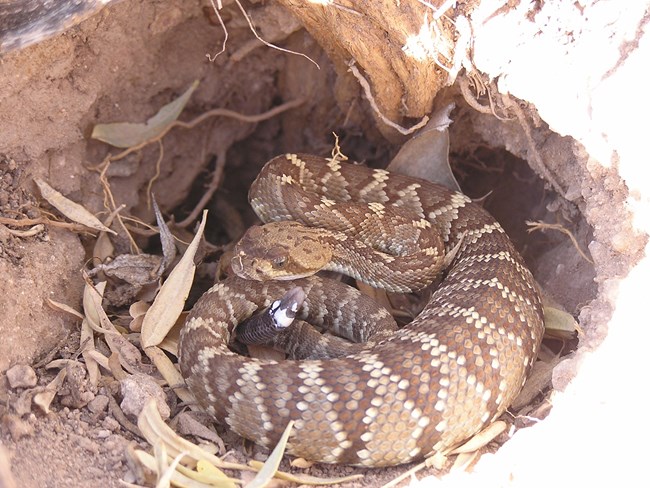
Photo by Erika Nowak Snakes are important part of the Verde Valley ecosystem and an iconic symbol of the southwest.
As a general rule in the desert, remember to never put your hands or feet anywhere your eyes have not been first. If you are ever bitten by a snake, do not attempt to treat yourself. Many folk remedies do more harm than good. Call 911 and go to the nearest hospital immediately. If bitten by a rattlesnake, you do not need to identify which species has bitten you. Non-Venomous SpeciesSeveral species of snakes are found at Montezuma Castle and Montezuma Well, most of which are not venomous. However, even the most laidback snakes will still bite if they feel threatened. 
Photo by Doggrell Coachwhip (Masticophis flagellum)The coachwhip is a species of non-venomous colubrid snake and can measure over eight feet long. They range throughout the southern United States from coast to coast. They vary greatly in color and have thin bodies with small heads and large eyes. Their prey consists of lizards, small birds, and rodents. They subdue prey by grasping and holding them with their jaws and do not use constriction. Coachwhips are fast snakes and can travel up to four miles per hour.
NPS Photo / Case Griffing Gophersnake (Pituophis catenifer)The gophersnake is a non-venomous colubrid snake endemic to North America and they are found in a variety of habitats. They can grow up to six feet in length and will sometimes mimic a rattlesnake when they feel threatened by shaking their tail. They are generally calm and will not bite unless provoked. They are often mistaken for rattlesnakes especially since young gophersnakes are born with very similar markings to help protect them from predators. Gophersnakes prey on small mammals, frogs, and other snakes. There are currently 11 subspecies of gophersnake recognized.
Photo by Alan Schimierer Black-necked Garter Snake (Thamnophis cyrtopsis)This small species is found throughout the southwest and inhabits areas close to water sources such as Beaver Creek. At most, these snakes only grow to be about 28 inches in length. Large clusters of them may be seen in the spring during the breeding season. They will excrete a foul-smelling musk to deter predators or when threatened. Frogs and toads are their main food source. 
Photo by L. Wolf; Creative Commons 2.0 Kingsnake (Lampropeltis getula)Kingsnakes have a wide range and are found from the Pacific Coast to the Atlantic across the southern half of the United States. Although large in size, they are laid-back in nature. Their appearance varies across subspecies. These snakes will prey on other snakes including rattlesnakes as well as lizards, rodents, and amphibians.Venomous SpeciesOnly the Western diamondback, black-tailed rattlesnake, and Western coral snake live in or around Montezuma Castle National Monument on a regular basis.
NPS Photo / Cookie Ballou Black-tailed Rattlesnake (Crotalus molossus)This medium-sized species can reach up to 42 inches in length and ranges in color from yellows and olive greens to browns and blacks. As their name suggests, the end of their tail is usually solid black, unlike the Western diamondback or Mojave rattlesnake. The black-tailed rattlesnake is found in the southwestern United States, Gulf of California, and Mexico. Their primary food source is mammals and birds. This species is considered to be one of the most docile rattlesnakes because of its calm demeanor and curious nature. Bites are rare but they will still bite in self-defense.
Photo by Patrick Alexander Western Diamondback (Crotalus atrox)This species is commonly found in the southwestern United States and Mexico. They are assertive and more likely to hold their ground than other snakes. It thrives in a variety of habitats from flat coastal plains to steep rocky canyons and hillsides. Western diamondback rattlesnakes are social during mating season and are usually inactive October through March. Their prey consists of anything they can fit in their mouth and are not picky eaters. They typically have black and white bands of equal width at the end of their tail and the dark patches along their backs are diamond-shaped. There is a good chance to see this species during your visit to Montezuma Castle and Montezuma Well during the summer months.
Photo by Patrick Alexander Mojave Rattlesnake (Crotalus scutulatus)Also called the Mojave green because of its occasional greenish color, this rattlesnake is highly venomous and typically found in the high deserts or lower mountain slopes of the southwest. It is considered one of the world's most potent rattlesnakes due to having two types of venom. While they have not been documented at Montezuma Castle, there was one documented at Tuzigoot National Monument in 2020 and may be occasionally found in the area. Usually the white bands at the end of their tails are much thicker than the black bands and the dark patches along their back tend to be rectangular. Their prey includes small mammals and reptiles.
USFWS Photo / Jeff Servoss Western Coral Snake (Micruroides euryxanthus)This small, brightly colored snake stands out among many of the snake species found in the park. Although highly venomous, they are not aggressive. They can be confused with similar looking milksnakes and are usually found in rocky terrain on low mountain slopes and open areas. Montezuma Castle is near the northernmost part of their range and they are found in central and southern Arizona, southwestern New Mexico, and northern Sinaloa. They primarily feed on other snakes. |
Last updated: May 5, 2025
